Fig. 1.
Development of locomotion is associated with a reversal of late adaptation. A: intracellular recording of a sartorius motoneuron (Sart MN; top) and electroneurograms (ENGs) from left quadriceps (Q) and left and right sartorius. With the onset of mesencephalic locomotor region (MLR) stimulation, tonic activity appeared (a), followed by irregular stepping (b), then more robust stepping with some deletions of the hyperpolarizing component of the locomotor drive potential (c), and, finally, well-developed fictive locomotion (d). The ENG traces demonstrate fictive locomotor activity with the characteristic rhythmic alternation between flexor (sartorius) and extensor (quadriceps) ENG activity as well as between left and right limb activity. B: averaged instantaneous firing frequencies of this motoneuron during the same 220-s trial of locomotion demonstrate the reversal of adaptation as fictive locomotion developed. The letters a–d along the abscissa correspond to those in A, showing where the 5-s extracts fit in the context of the entire trial. At the onset of tonic activity (a), firing gradually increased in frequency, then after ~20 s the average instantaneous frequency began to decrease. This was the onset of adaptation, which continued through the onset of irregular stepping (b). When the locomotion became more robust (c), the adaptation reversed, and this reversal continued throughout the period of fictive locomotion (d).

